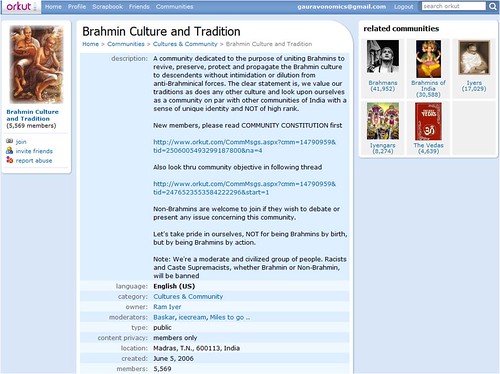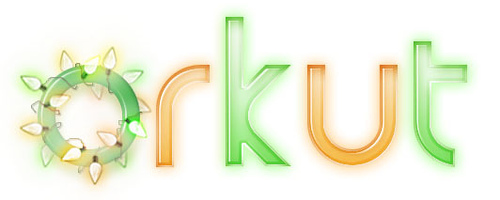One of the main themes of my research on digital activism is that social technologies are value-agnostic [1].
At each of the four levels of Content, Collaboration, Community and Collective Intelligence [2], social technologies can lead to both good and bad outcomes.
I have written before about Shiv Sena's militant approach towards Orkut communities critical of the party, its leader Bal Thakeray, or its Hindutva ideology [3]. Caste-based communities [4] on Orkut [5] are another disturbing example of online communities mirroring the dysfunctions in Indian society.

For instance, there are more than 1000 communities for Brahmins on Orkut [6]. There are 461 Brahmin communities listed under culture and community [7], 591 under religion and beliefs [8], 87 under activities [9] and 117 under others [10].
One of the most popular Brahmin [11] community, with 28, 726 members, randomly claims: “we r clever & hardworking. no one can fool us…” The Brahmans [12] community with 41952 members and the Brahmins of India [13] community with 30588 members are also very popular.
The other popular Brahmin communities are those for the various Brahmin sub-castes like Gawd Saraswat Brahmin (GSB) [14] (12,189 members), Kokanastha Brahmin [15] (4038 members), Deshashtha Brahmin [16] (4083 members), Garhwali Brahmin [17] (3067 members), Daivadnya Brahmin [18] (2654 members) and Gaur Brahmin [19] (2055 members). Another group, Brahmin Culture and Tradition [20] is “dedicated to the purpose of uniting Brahmins to revive, preserve, protect and propagate the Brahmin culture to descendants without intimidation or dilution from anti-Brahminical forces.”
Interestingly, it seems that most of the threads under topics related to Brahmins [21] have to do with defining the different types of Brahmins under various sub-castes.
There are also more than 1000 communities for Yadavs on Orkut [22], including gems like modern yadav girls and boys [23] (5759 members).
Similarly, there are more than a 1000 Rajput communities on Orkut [24], including the Rajput the Royal Family [25] community with 35,481 mebers, which asks people to join the group “if your soul justifies that you are Rajput both by soul and by nature.”
Dalits [27] have about 200 mostly small communities on Orkut.
Perhaps, the low number of Dalit communities on Orkut says something about Indian society in general, and Orkut users in particular. Higher, more powerful, castes like Brahmins, Rajputs and Yadavs tend to have more money and easier access to the internet and old disparities are further accentuated by the internet.
Caste-based communities, however, aren't unique to Orkut.
Brahminsamaj.org [28] is “a global platform for the Brahmin Community where you will learn, share and find lot of information, knowledge and fun.” Thambraas Muhurtham [29] wants that “all Brahmins should come forward to marry breaking the sects and subsects within Brahmins, particularly Brahmins of Thamizhnadu.” It also points out that “the entire sects and subsects of South Indian brahmin population are totally vegetarians unlike certain brahmins of other parts of India.” A couple on the homepage of Marry A Brahmin [30] claim that its “focused approach on Brahmin matches helped us find each other as true soul mates.” Brahmin Connections [31] is “proud to present an opportunity and a platform to our young Brahmins and their parents to connect with each other across the world for the matrimonial purpose.” Brahmins Matrimony [32] says that “it is the right place to search for your life partner!”
There are dedicated websites for sub-castes as well. Sakhdwipi [33] aims “to provide a common forum for the Shakdwipis to know each other and interact with each other.” KeralaIyers [34] aims “to delve into the history, trace the roots, portray the life of modern day Kerala Iyers, and chronicle the achievements of this community.” iKalyanam [35] claims to be “the only exclusive site for Iyer matrimonials.” Shivalli Brahmins [36] wishes “to bring together all Shivalli Brahmins residing in different parts of the world, through meaningful discussions about their traditions.” GSBMatch [37] is a matrimonial website for the Gowd and Saraswat Brahmin community. ModhBrahmin.org [38] and BrahmanSamaj.org [39] claim that “history proves that the people of Modh Brahmin Samaj are very enterprising and very resourceful” and aims to “bring all brothers and sisters of Samaj close.” Jangid Brahmin Samaj [40] is a community for Jangid Brahmins. RSBNet [41] is “a single stop source of information regarding the origin, customs, culture, history of Rajapur Saraswath Brahmins.”
Similarly, there are dedicated websites for other castes as well.
Kayastha Matrimonial [42] is a matrimonial website for the Kayastha community. Rajput Samaj [43] is “presently predominately taking care of the Rajputs of Rajasthan” but in near future aims to be “taking care of the Rajputs living in India, Pakistan and abroad.” JatLand [44], “the online home for the Jats” is especially proud of its wiki [45].
The Dalit community is fairly active on the internet, even though it's miniscule on Orkut. The International Dalit Solidarity Network [46], which has the most sophisticated of all these websites, “works on a global level for the elimination of caste discrimination.” Dalit Solidarity Network [47] “brings together organizations and individuals in the UK who are concerned with caste-based discrimination.” Dalit India [48] has “papers on various specific issues of the Dalits of India living in India and abroad.” Dalit Freedom Network [49] “partners with the Dalits in their quest for religious freedom, social justice, and human rights by mobilizing human, informational, and financial resources.” Dalit Solidarity [50] is “committed to the principles of justice and equality for all Indians, regardless of caste, race, gender or religion.” Dalit Voice [51] claims that India is “the original home of racism” as Dalits and Tribals, who “constitute the core of India's original inhabitants”, are kept enslaved by “alien Aryans”. Dalit Education [52] aims to “transform lives and communities through the Christian message.” Indian Dalit Muslims Voice [53] is a platform to discuss issues concerning Indian Dalit Muslims. Rohit Chopra [54] has written about the tension between the elite Hindu nationalists and the disadvantaged Dalits on the internet.
In terms of content, the majority of these websites are focused on matrimonial match-making, but several of them seek to build international communities based on caste affiliations and offer tools like directories, bulletin boards and forums to their members. I have also noticed a tendency to establish a rather embellished history of the caste, with detailed biographies of the important personalities belonging to the caste. Ashok Kumar at Express India [55] has a great description of the common features on these caste based websites.
Not surprisingly, Facebook has only 46 small Brahmin groups [56], 60 small Yadav groups [57], 126 smal Rajput groups [58] and 41 small Dalit groups [59]. The absence of caste based groups from Facebook is in line with its cosmopolitan user base. Orkut, on the other hand, should be a little concerned about its tendency to attract loonies of all types.
In the end, however, the cosmopolitanism of Facebook is an anomaly, and Orkut's crude caste communities merely mirror India's splintered society.
Cross-posted at Gauravonomics, my blog on social media and social change [60].
